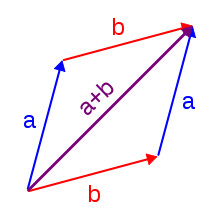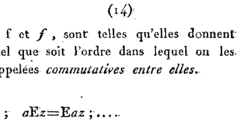
A | B | C | D | E | F | G | H | CH | I | J | K | L | M | N | O | P | Q | R | S | T | U | V | W | X | Y | Z | 0 | 1 | 2 | 3 | 4 | 5 | 6 | 7 | 8 | 9
 | |
| Type | Property |
|---|---|
| Field | Algebra |
| Statement | A binary operation is commutative if changing the order of the operands does not change the result. |
| Symbolic statement | |
In mathematics, a binary operation is commutative if changing the order of the operands does not change the result. It is a fundamental property of many binary operations, and many mathematical proofs depend on it. Perhaps most familiar as a property of arithmetic, e.g. "3 + 4 = 4 + 3" or "2 × 5 = 5 × 2", the property can also be used in more advanced settings. The name is needed because there are operations, such as division and subtraction, that do not have it (for example, "3 − 5 ≠ 5 − 3"); such operations are not commutative, and so are referred to as noncommutative operations. The idea that simple operations, such as the multiplication and addition of numbers, are commutative was for many years implicitly assumed. Thus, this property was not named until the 19th century, when mathematics started to become formalized.[1][2] A similar property exists for binary relations; a binary relation is said to be symmetric if the relation applies regardless of the order of its operands; for example, equality is symmetric as two equal mathematical objects are equal regardless of their order.[3]
Mathematical definitions
A binary operation on a set S is called commutative if[4][5] In other words, an operation is commutative if every two elements commute. An operation that does not satisfy the above property is called noncommutative.
One says that x commutes with y or that x and y commute under if That is, a specific pair of elements may commute even if the operation is (strictly) noncommutative.
Examples

Commutative operations

- Addition and multiplication are commutative in most number systems, and, in particular, between natural numbers, integers, rational numbers, real numbers and complex numbers. This is also true in every field.
- Addition is commutative in every vector space and in every algebra.
- Union and intersection are commutative operations on sets.
- "And" and "or" are commutative logical operations.
Noncommutative operations
Some noncommutative binary operations:[6]
Division, subtraction, and exponentiation
Division is noncommutative, since .
Subtraction is noncommutative, since . However it is classified more precisely as anti-commutative, since .
Exponentiation is noncommutative, since . This property leads to two different "inverse" operations of exponentiation (namely, the nth-root operation and the logarithm operation), which is unlike the multiplication. [7]
Truth functions
Some truth functions are noncommutative, since the truth tables for the functions are different when one changes the order of the operands. For example, the truth tables for (A ⇒ B) = (¬A ∨ B) and (B ⇒ A) = (A ∨ ¬B) are
A B A ⇒ B B ⇒ A F F T T F T T F T F F T T T T T
Function composition of linear functions
Function composition of linear functions from the real numbers to the real numbers is almost always noncommutative. For example, let and . Then and This also applies more generally for linear and affine transformations from a vector space to itself (see below for the Matrix representation).
Matrix multiplication
Matrix multiplication of square matrices is almost always noncommutative, for example:
Vector product
The vector product (or cross product) of two vectors in three dimensions is anti-commutative; i.e., b × a = −(a × b).
History and etymology

Records of the implicit use of the commutative property go back to ancient times. The Egyptians used the commutative property of multiplication to simplify computing products.[8][9] Euclid is known to have assumed the commutative property of multiplication in his book Elements.[10] Formal uses of the commutative property arose in the late 18th and early 19th centuries, when mathematicians began to work on a theory of functions. Today the commutative property is a well-known and basic property used in most branches of mathematics.
The first recorded use of the term commutative was in a memoir by François Servois in 1814,[1][11] which used the word commutatives when describing functions that have what is now called the commutative property. Commutative is the feminine form of the French adjective commutatif, which is derived from the French noun commutation and the French verb commuter, meaning "to exchange" or "to switch", a cognate of to commute. The term then appeared in English in 1838.[2] in Duncan Gregory's article entitled "On the real nature of symbolical algebra" published in 1840 in the Transactions of the Royal Society of Edinburgh.[12]
Zdroj:https://en.wikipedia.org?pojem=Commutative_propertyText je dostupný za podmienok Creative Commons Attribution/Share-Alike License 3.0 Unported; prípadne za ďalších podmienok. Podrobnejšie informácie nájdete na stránke Podmienky použitia.
Antropológia
Aplikované vedy
Bibliometria
Dejiny vedy
Encyklopédie
Filozofia vedy
Forenzné vedy
Humanitné vedy
Knižničná veda
Kryogenika
Kryptológia
Kulturológia
Literárna veda
Medzidisciplinárne oblasti
Metódy kvantitatívnej analýzy
Metavedy
Metodika
Text je dostupný za podmienok Creative
Commons Attribution/Share-Alike License 3.0 Unported; prípadne za ďalších
podmienok.
Podrobnejšie informácie nájdete na stránke Podmienky
použitia.
www.astronomia.sk | www.biologia.sk | www.botanika.sk | www.dejiny.sk | www.economy.sk | www.elektrotechnika.sk | www.estetika.sk | www.farmakologia.sk | www.filozofia.sk | Fyzika | www.futurologia.sk | www.genetika.sk | www.chemia.sk | www.lingvistika.sk | www.politologia.sk | www.psychologia.sk | www.sexuologia.sk | www.sociologia.sk | www.veda.sk I www.zoologia.sk














